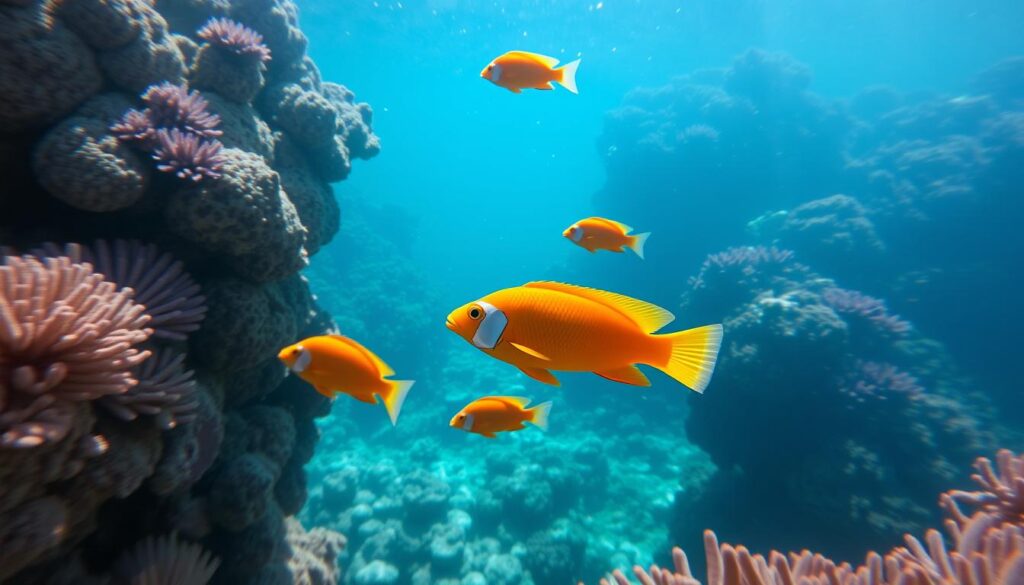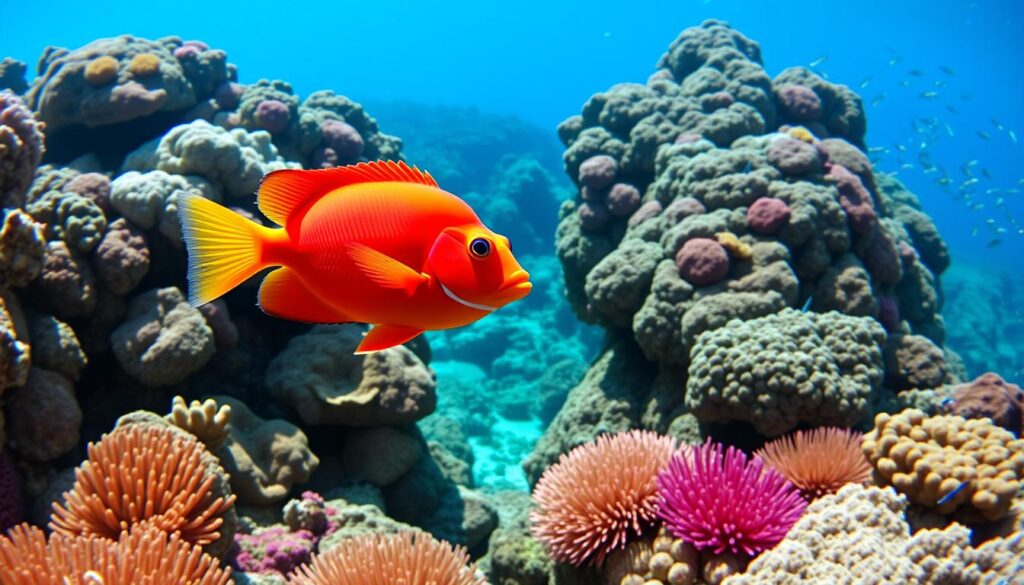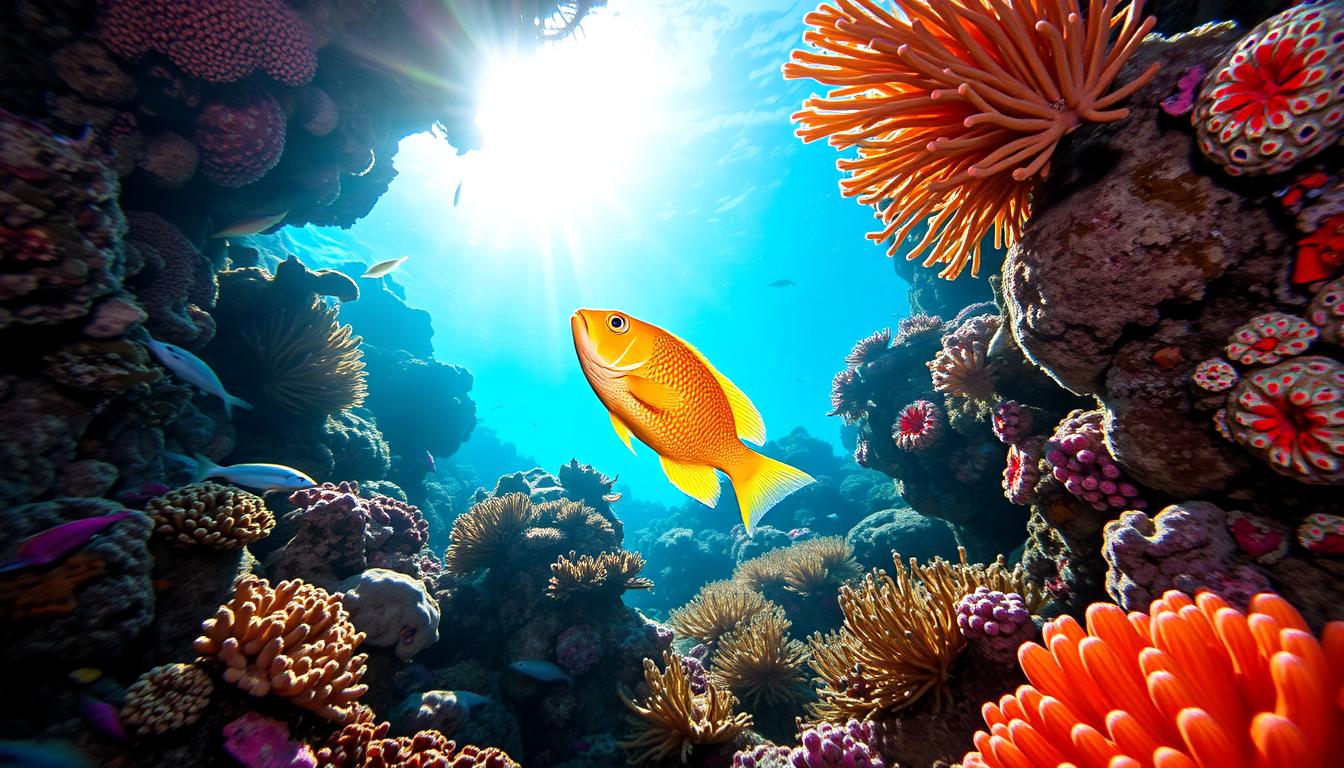Ever wondered about California’s official marine state fish? The Garibaldi is a vibrant orange gem in the Golden State’s waters. It’s the largest in the Damselfish family, growing up to a foot long. This makes it a stunning sight underwater.
What makes the Garibaldi so special to Californians? Learn about its fascinating facts. Find out why it’s a beloved symbol of California’s diverse and beautiful aquatic world.
Table of Contents
Introduction to California’s Marine Icon
The garibaldi fish, known as Hypsypops rubicundus, is a key part of California’s coast. Being the state fish highlights its importance and pushes for its protection. Its bright orange color and special behaviors make it a symbol of California’s marine life.
The Channel Islands are a unique place, often called the “Galapagos of North America.” They are home to many marine species, including the garibaldi fish. The kelp forests around these islands are very tall, up to 60 to 70 feet, and provide a home for many creatures.
Recently, the Channel Islands’ marine world has been explored by several expeditions. Blancpain has supported three of these, with the next one set for 2025. These trips have let researchers and divers see the underwater world, including the garibaldi fish and other fascinating sea creatures.
Citizen science programs, like the one in California, are key in watching over the coast. Over 2,000 volunteers have been trained since 2006. They have done over 1,000 surveys to count fish, invertebrates, and kelp. This data helps everyone work together to protect these delicate ecosystems.
The garibaldi fish is a bright orange, iconic symbol of California’s sea. As the state’s official marine fish, it reminds us of the need to keep these coastal areas safe for future generations.
Physical Characteristics and Appearance
The garibaldi fish is a bright orange marine icon in California. It has a strong body and is the largest damselfish species. Adults can grow up to 12 inches long, making them a stunning sight underwater.
Size and Body Structure
Garibaldi fish have a sturdy build and large size. They are a great example of California’s marine life diversity. Their bodies are streamlined, and their fins are powerful, helping them move through rocky reefs easily.
Distinctive Orange Coloration
The garibaldi’s bright orange hue warns predators and is key in their mating. This color earned it the title of California’s official state marine fish.
Juvenile vs. Adult Features
Garibaldi fish change a lot as they grow. Young ones have bright blue spots that turn into their distinctive orange coloration as they mature. This change is one of the many interesting things about these fish.

Natural Habitat and Distribution
The Garibaldi fish, also known as the Catalina goldfish, is a vibrant marine icon found along the coastline of California and Baja California. These saltwater aquarium fish and marine fish thrive in the rocky reefs and kelp forests of the eastern Pacific Ocean, particularly around Catalina Island. Garibaldi fish typically inhabit shallow waters, preferring depths ranging from 3 to 30 meters, where the water temperatures are comfortably warm, between 15°C and 22°C.
As adults, Garibaldi fish can grow up to 14 inches in length, making them significantly larger than their freshwater goldfish counterparts. These distinctive, brightly-colored fish are well-suited to their natural environment, as their habitat preferences and tolerance for warmer waters allow them to flourish in the coastal regions of Southern California.
Efforts to protect the natural habitats of the Garibaldi fish are crucial for the conservation of this marine species. While the Garibaldi is not currently listed as endangered or threatened, it faces ongoing threats from pollution, overfishing, and habitat destruction. Marine protected areas (MPAs) around Catalina Island and other parts of Southern California provide some safeguards for the Garibaldi’s populations.
| Characteristic | Garibaldi Fish | Garibaldi Damselfish |
|---|---|---|
| Native Range | California and Baja California, USA | Northeast Temperate Pacific Ocean |
| Habitat Depth | 3-30 meters | 0-30 meters |
| Maximum Size | 14 inches | 25-30 cm |
| IUCN Status | Not Listed | Least Concern |
The Garibaldi fish holds a significant cultural significance in the Southern California region, inspiring various artistic works and merchandise. As the state marine fish of California, the Garibaldi serves as a beloved symbol of the state’s vibrant marine ecosystems and the need to preserve them for future generations.

Behavioral Patterns and Social Structure
The garibaldi fish, with its bright orange color, shows interesting behaviors and social life. These marine animals are very territorial, especially when they’re breeding. Males will fight hard to protect their nesting sites.
Territorial Nature
Garibaldi fish are fiercely territorial. They mark their own areas in the ocean. They use their bright colors and aggressive moves to keep others away.
This behavior helps them stay in charge of their reef tank home.
Mating Rituals
The mating rituals of garibaldi fish are truly captivating. During breeding time, males show off with bright colors and fast swimming. They try to attract females this way.
Once a female is interested, the male prepares and guards the nesting site. He makes sure the eggs are fertilized and cared for.
Daily Activities
In their natural home, garibaldi fish are always on the move. They are skilled foragers, searching for small animals and food on the reef. They also interact with other sea creatures, showing their social side.
The garibaldi fish’s behavior and social life show the beauty and complexity of California’s sea life. Learning about these fish can make you appreciate the reef tank fish and the orange damselfish more.
Diet and Feeding Habits
The garibaldi fish are colorful marine icons of California. They are omnivorous, eating a wide range of foods in their natural home. These fish mainly eat small invertebrates and algae, playing a key role in Pacific coastal ecosystems.
In the wild, garibaldi fish eat sponges, bryozoans, small crustaceans, and types of algae. Their varied diet helps them stay healthy and keeps their marine home balanced. It also controls algae and small invertebrate growth.
For those keeping marine aquarium fish and saltwater aquarium fish, it’s crucial to feed garibaldi like they do in the wild. They need a mix of meaty foods and plant-based items. This ensures they get the nutrients they need to thrive in captivity.
| Garibaldi Fish Diet | Wild Diet | Aquarium Diet |
|---|---|---|
| Main Food Sources | Sponges, bryozoans, small crustaceans, algae | Meaty foods, plant-based matter |
| Feeding Behavior | Controlling algae growth, small invertebrate populations | Maintaining overall health and well-being |
Understanding garibaldi’s natural diet helps aquarium hobbyists keep them healthy. A balanced diet is essential for these fish to thrive. It supports their role in Pacific coastal ecosystems.
Life Cycle and Reproduction
The garibaldi fish is a key marine fish in California. Its life cycle and reproduction are quite interesting. These details help us understand its role in the ocean and how to protect it.
Breeding Season
The breeding season for garibaldi fish is in late spring and early summer. As the water gets warmer, they become more active. They start their courtship rituals.
Nesting Behavior
Male garibaldi fish are very territorial. They prepare and guard the nesting sites. They use their bright orange color and displays to attract mates.
Once a female is interested, the pair will spawn together. The male protects the eggs until they hatch.
Growth Stages
- Juvenile garibaldi fish go through several distinct growth stages, with their appearance changing significantly as they mature.
- In their early life, juvenile garibaldi exhibit a mottled brown or gray coloration, which helps them blend in with their surroundings and avoid predators.
- As they grow older, their vibrant orange hues gradually develop, marking their transition to adulthood and their role in the intricate marine fish ecosystem.
By understanding the life cycle and reproductive strategies of the garibaldi fish, researchers and conservationists can better protect and manage this iconic damselfish species within the diverse marine environments of California.
Garibaldi Fish in Marine Ecosystems
The garibaldi fish are key players in California’s marine world. They live in coastal reefs and help keep the balance. They eat algae and feed bigger fish, keeping the ecosystem healthy.
Garibaldi fish are very territorial. This affects how other fish live and grow in their area. Knowing how reef tank fish and marine aquarium fish like garibaldi work is important. It helps us create better homes for them in aquariums.
| Ecosystem Function | Contribution of Garibaldi Fish |
|---|---|
| Algae Control | Grazing on algae, preventing overgrowth and ensuring a healthy balance in the reef community. |
| Food Web Dynamics | Serving as a food source for larger predators, playing a vital role in the marine food chain. |
| Habitat Structuring | Their territorial behavior influences the distribution and interactions of other species in the reef ecosystem. |
Understanding the role of garibaldi fish in marine habitats is crucial. Aquarium lovers and conservationists can create better reef tank fish and marine aquarium fish homes. These homes will be more like their natural habitats.
Conservation Status and Threats
The garibaldi damselfish, California’s official marine state fish, is not endangered now. But, it faces many environmental challenges in its home. As a protected species, it has rules to keep it safe. Still, we need to keep working to save this important part of California’s sea life.
Current Population Status
The garibaldi damselfish is seen as “Least Concern” by the International Union for Conservation of Nature (IUCN). This means its numbers are steady. Yet, it’s still at risk from things like habitat loss, pollution, and climate change.
Environmental Challenges
A big marine heatwave has made life hard for sea creatures, including the garibaldi damselfish. Warmer waters can cause coral bleaching, ocean acidification, and harm kelp forests. These are key places for the garibaldi and other sea animals.
Protection Measures
California has set up a big network of Marine Protected Areas (MPAs) along its coast. These areas cover over 1,110 miles. They help keep the sea healthy, with more life and better conditions for the garibaldi. It’s important to keep watching over these areas and make sure they stay safe for the garibaldi and all sea life.

